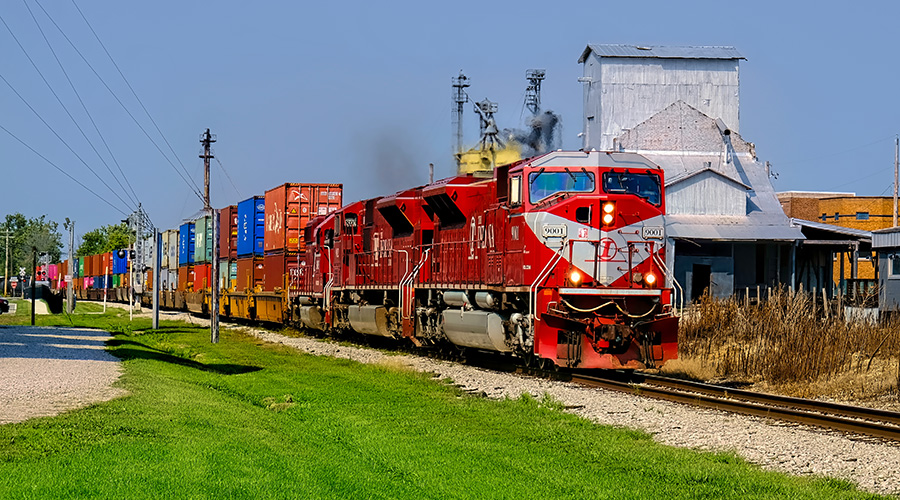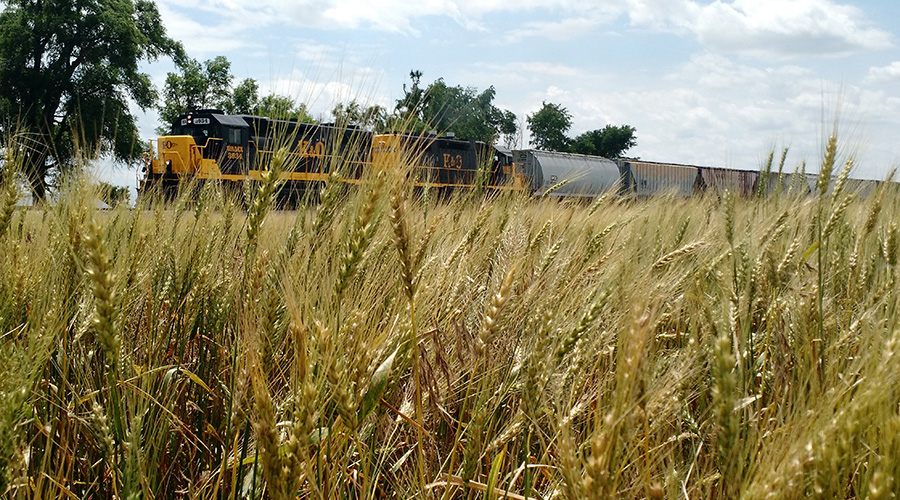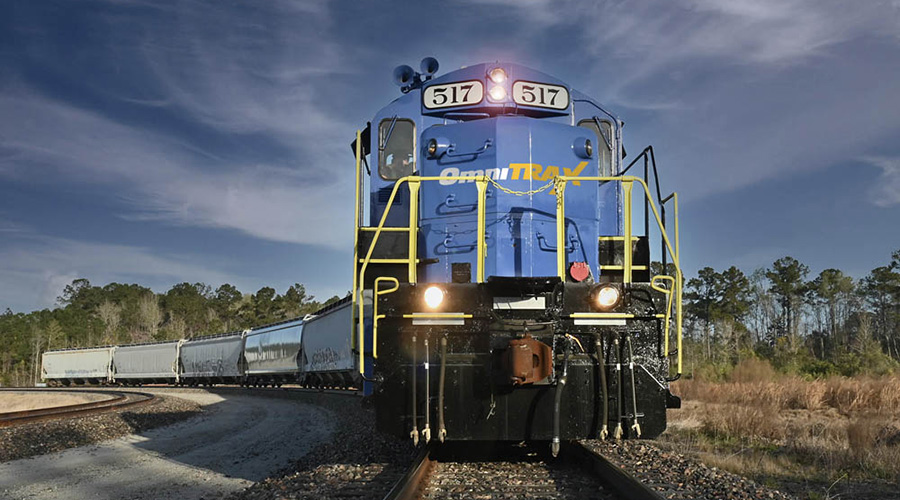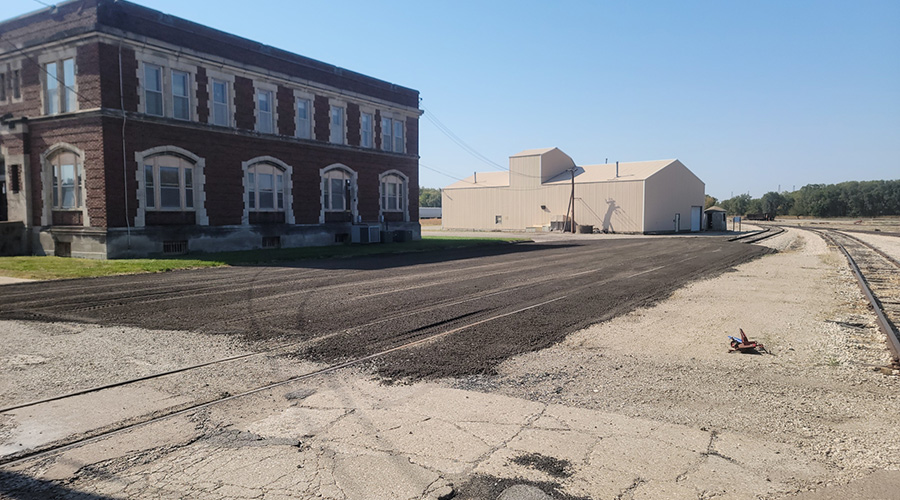Carloads crept up for many short lines in the third quarter or through September
10/28/2024
By Jeff Stagl, Managing Editor
The third quarter capped an encouraging traffic-building period for short lines. Although their carloads declined in nine of 14 commodity groups through 2024’s first nine months, small railroads’ total volume increased about 0.8% year over year to 4,508,820 units, according to the RailConnect Index of Shortline Traffic.
Compiled by Wabtec Corp.’s GE Transportation unit, the index reflects traffic data from 458 regionals and short lines for the period ending Sept. 28, or 2024’s first 39 weeks.
The major gainer among commodity groups in the 39-week period was intermodal. The index shows short lines’ intermodal volume grew 13.6% to 759,931 units. The railroads also registered increases, albeit much smaller ones, for shipments of ores (3.8% to 127,132 units), chemicals (1.7% to 775,422 units), motor vehicles and equipment (0.7% to 151,056 units), and grain (0.7% to 513,792 units).
The biggest year-over-year decliners among traffic categories through 39 weeks were coal, at 9.7% (to 191,793 units); “all other” carloads, at 6.5% (to 74,385 units); paper products, at 4% (to 228,921 units); stone/clay/aggregates, at 3.8% (to 521,730 units; and metals, at 3.5% (to 336,071 units).
 An uptick in ag product carloads helped boost Watco’s Q3 traffic by 2.3%. Shown: Watco’s Kansas & Oklahoma Railroad, which moves a lot of grain and grain products. Watco
An uptick in ag product carloads helped boost Watco’s Q3 traffic by 2.3%. Shown: Watco’s Kansas & Oklahoma Railroad, which moves a lot of grain and grain products. WatcoShort lines posted smaller drops — ranging from 1.6% to 1.1% — for carloads of farm and food products excluding grain, lumber and forest products, waste and scrap materials, and petroleum and coke.
Using the RailConnect index as macro data, RailPrime each quarter aims to drill down to the micro level by polling a cross section of regionals, short lines and holding companies about their volume results. Following are responses about third-quarter and nine-month traffic performance gleaned from emails or interviews.
For Genesee & Wyoming Inc. (G&W), Q3 volume in North America rose about 5% year over year. The company owns more than 100 regionals and short lines in North America.
“We saw positive momentum across most commodities, offset slightly by lower metals and pulp & paper traffic driven by specific facility issues, inventory rebalancing and continued pressure from lower trucking rates,” G&W officials said.
 Petroleum products, chemicals and minerals highlighted Q3 carload gains across most commodity groups for OmniTRAX, which owns more than 30 small railroads. OmniTRAX Inc.
Petroleum products, chemicals and minerals highlighted Q3 carload gains across most commodity groups for OmniTRAX, which owns more than 30 small railroads. OmniTRAX Inc.Q3 a positive period for Watco
Watco had a promising quarter, as well. The owner of about four dozen regionals and short lines logged a 2.3% traffic gain on a year-over-year basis. And through 2024’s first nine months, the company’s volume rose 1.4%.
The quarterly traffic gain boiled down to three primary drivers: crude oil loads shot up 29.3%, coal carloads climbed 19.8% and agricultural products volume increased 3.8%, said Watco Senior Vice President of Rail Operations Jimmy Patterson.
“With that said, the following commodities have seen unfavorable movement: chemicals down 7% and metals down 9.2%,” he said.
For OmniTRAX Inc., the company’s leaders characterize Q3 as a “terrific quarter.” Overall traffic for OmniTRAX — which owns more than 30 regionals and short lines — was up by a percentage in the mid-single digits.
 The 580-mile regional’s Q3 carloads climbed 10% in part because strong fuel demand helped drive up shipments of ethanol and dried distillers grains. Iowa Interstate Railroad/A.O. Hunt
The 580-mile regional’s Q3 carloads climbed 10% in part because strong fuel demand helped drive up shipments of ethanol and dried distillers grains. Iowa Interstate Railroad/A.O. Hunt“Petroleum products, chemicals and minerals highlighted gains across almost all commodity groups, and more than offset continued weakness in the energy sector,” said OmniTRAX Senior VP of Commercial Operations Brian Ward.
On a year-to-date basis, the company’s traffic through three quarters was tracking on par with 2023.
“But we expect that to improve based on the Q3 momentum and our current outlook with strength across commodity groups, including a good harvest for grain shipments,” said Ward.
Traffic zooms for Iowa Interstate
Traffic strength was evident in Q3 at Iowa Interstate Railroad LLC (IAIS), as well. The 580-mile regional’s carloads climbed 10%, in part because strong fuel demand resulted in higher shipments of ethanol and dried distillers grains.
“Grain carloads were up with shipments normalizing this crop year,” IAIS officials said. “In addition, growth in containerized agricultural intermodal traffic contributed to the increase in the third quarter carloads.”
Through three quarters, the railroad’s carloads rose 3%. Grain volume was up significantly as volume normalized after the 2022-23 crop year, which generated poor yields due to draught conditions in IAIS’ grain territory.
“Growth in intermodal, forest products and aggregate volume also drove the increase,” IAIS officials said. “[But] metals traffic has been down this year due to soft demand for supplying the ag machinery manufacturers and the overall slowdown in the ag economy.”
Q3 traffic was in the red for the New Orleans Public Belt Railroad (NOPB), too, rising 6% year over year.
 Through three quarters, RRVW’s volume shot up 20% due to strong grain, fertilizer and steel volumes. For example, there was high demand for steel used to manufacture equipment. Red River Valley & Western Railroad Co.
Through three quarters, RRVW’s volume shot up 20% due to strong grain, fertilizer and steel volumes. For example, there was high demand for steel used to manufacture equipment. Red River Valley & Western Railroad Co.“This increase is the result of a strong local customer movement of commodities,” NOPB officials said. “Highlighted commodities from the third quarter include plywood, renewable diesel and cement.”
Meanwhile, strong Q3 volume showed Sierra Northern Railway’s traffic continues to grow at a high pace. The short line held its long ongoing streak of double-digit carload gains through the quarter.
And through three quarters, volume was tracking at about a 16% increase for 2024, said Kennan Beard, the northern California short line’s president and CEO.
“We are experiencing growth across the company, with our brick-and-mortar customers and in transloading, inland port as well as car storage [business],” he said.
Sizzling results for sister roads
Sister railroads Red River Valley & Western (RRVW) and Twin Cities & Western (TCWR) also are experiencing solid traffic growth. In Q3, the 500-mile RRVW registered a 28% traffic gain while the 360-mile TCWR notched an 18% volume compared with Q3 2023 figures. TCWR’s volume is consolidated along with its Minnesota Prairie Line and the Sisseton Milbank Railroad subsidiaries.
Through three quarters, RRVW’s volume shot up 20% in part because fertilizer loads rose 15% driven largely by customer expansions and steel loads climbed 17% driven by higher demand for steel used in equipment manufacturing, said Victor Meyers, who serves as president of both RRVW and TCWR. But the ultimate traffic driver was grain business.
“Grain carloads were up 63% driven by steady export demand for corn,” said Meyers. “Grain carloads were incredibly soft on RRVW in 2023 and the [current] year-to-date volumes represent more normalized activity, although we experienced stronger demand for corn over the summer months when compared to prior years.”
For TCWR, volume through three quarters increased 6%. Grain carloads only inched up 1% as domestic grain demand remained consistent, but three other commodity groups provided big boosts.
“Aggregate carloads were up 167% driven by a new aggregate transload; sugar carloads were up 19% due to increased production from the 2023 crop and strong domestic demand for sugar; and ethanol carloads were up 6% driven largely by increased customer production,” said Meyers.
Ups and downs at RBMN, INRD
But it was an uneven quarter for the 400-mile Reading, Blue Mountain & Northern Railroad Co. (RBMN).
The regional’s two largest commodity groups — coal and forest products — continued to show traffic strength. The railroad expects to end the year close to double-digit volume growth in those groups, said RBMN President Wayne Michel.
“But on the other hand, our frac sand business has followed the rest of the Marcellus [Shale] industry and is down significantly,” he said.
The Indiana Rail Road Co. (INRD) has had similar up-and-down traffic results of late. The railroad’s volume through three quarters climbed about 4.5% primarily because of an international intermodal business partnership with CSX that was nearing its first full year, said INRD President and CEO Joe Gioe.
However, traffic results in Q3 were more of a mixed bag for the 500-mile regional, which operates in southern Indiana and central Illinois, including a line to Chicago.
“We had started the year strong, but the third quarter was not as good as the first two quarters,” said Gioe. “It wasn’t statistically concerning, more flat to slightly lower than the other quarters.”
The primary hinderance in Q3: brief strikes by the International Longshoremen's Association at East Coast ports and by the Teamsters Canada Rail Conference at CN.
Those work stoppages “steered off” intermodal freight from INRD, and so far that business hasn’t come back, said Gioe.
“The hangover of the strikes will take time to get over,” he said, adding that without the intermodal traffic hiccups, INRD likely would have registered its sixth straight quarter of traffic growth in Q3.
Still, transloading business and agricultural products volume were strong in the quarter.
Going forward, Gioe is optimistic that the worst is behind INRD, and traffic will pick up in Q4 and beyond. The allure of moving intermodal shipments through Indianapolis instead of congested Chicago is one reason for such optimism.
“Everyone loves Indianapolis as an alternative to Chicago,” said Gioe.
For the owner of the Paducah & Louisville Railway Inc., Evansville Western Railway Inc. and Appalachian and Ohio Railroad Inc., there have been many traffic-building hurdles so far in 2024. Among them: the partial Francis Scott Key bridge collapse in Baltimore, mine fires in West Virginia and utilities sitting on record coal inventories due to mild weather.
As a result, the company’s Q3 volume dropped about 3% from the previous quarter, mainly because of a reduction in coal traffic due to the high inventories at utilities, said Kevin McEwan, the firm’s VP of marketing and sales.
“We are down almost 12% year over year through the year’s first three quarters. Again, mainly driven by losses in utility coal and export pet coke,” he said.


